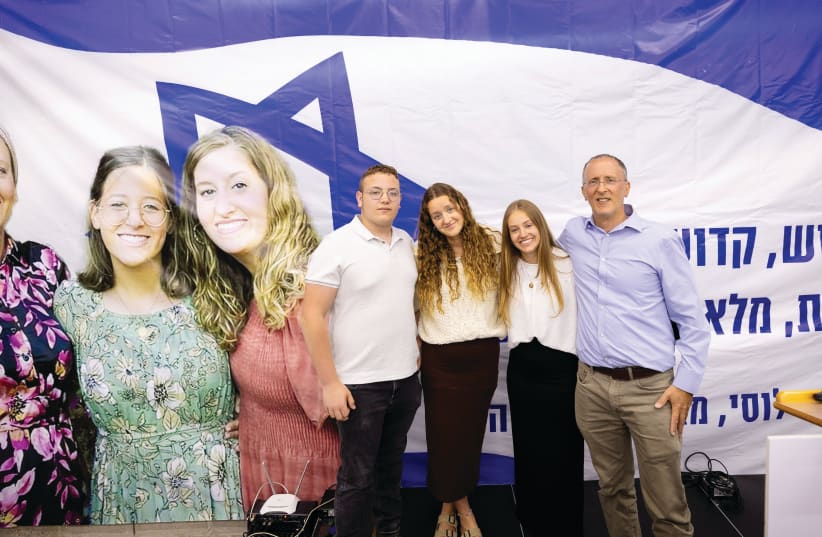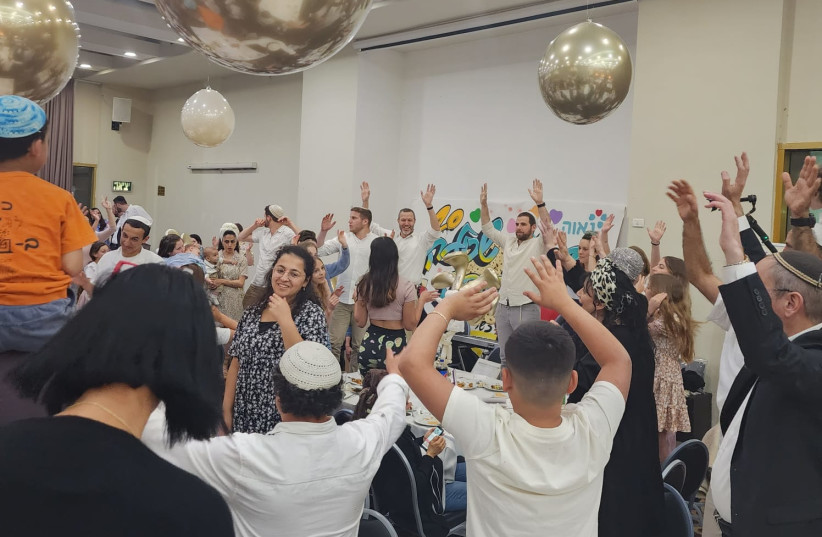Seder Night is called the Leil Shimurim (night of protection). Saturday night April 13/14 was our night of protection, when Iran bombarded Israel with more than 300 missiles and drones, and not one Jew was killed.
Last Seder night, I sat around my table with my wife, Lucy, our five children, and my parents, and we sang a song from the Haggadah: “VeHi SheAmda” (and this is what stood) to the tune by Yonatan Razel. It is a rousing melody, and I recall feeling a sense of joy and unity that I had not experienced before. Little did I know that just 36 hours later, I would be standing at the site of the terror attack that killed my wife and two daughters, Rina and Maia.
The song “VeHi SheAmda” became one of the songs that we sang at the two funerals and at the shloshim (the end of the 30 days of mourning,) and we will sing it again at their graves on their first yahrzeit.
The words of the song translate as follows: “And this is what stood up for our fathers and for us. For it was not only one who arose and tried to destroy us, but every generation has tried to destroy us, but Hashem saves us from their hands.”
The commentators all ask the obvious question: What is the “this” referred to in the song that enabled our national survival over thousands of years? They offer many different answers.
One obvious candidate is our faith in Hashem. This explanation is given by Rabbi Benyamin Dovid Rabinowitz (19th century, Warsaw). Our steadfast belief in the Creator and His eternal plan is what has accompanied us on this long journey and given us the strength to survive the worst of persecution and forced assimilation. For me and my three surviving children, our faith that Hashem has a plan, however cruel it feels to us, is one of the factors that has enabled us to get through this first year.
Faith, prayer, and survival
The Torah is another candidate, offered by Rabbi Tevele Bondi (19th century, Frankfurt). In the words of the contemporary rabbi, rabbi Y.Y. Jacobson, if scientists were to investigate which factor each surviving generation of Jews over the millennia had in common, they would have to reject wealth, influence, and power, as many generations in different locations had none of these. They would be left with one parameter, which is the Torah and mitzvot. Certainly, the daily, weekly, and annual cycle of a Torah lifestyle has literally been a “Godsend” to me and my family.
But our faith and the Torah are intellectual pursuits, and many of the commentators go down a different route – that of emotional commitment. Rabbi Chaim David Azulai, the Chida (18th century, Jerusalem,) suggests that it was prayer that protected us (exercising the Talmudic concept that “there is no standing except for prayer.”) I find solace in the “Standing Prayer” that I say three times a day. The first blessing is for Hashem, who “protects Abraham,” and I realize that for decades, I have been praying for Hashem to protect me, my family, my friends, and my people. But what happens when He does not? The next prayer is to Hashem, who “brings the dead back to life.”
OUR PRAYERS tell us that we cannot simply believe in an obedient God, Who will always fulfill our desire for protection, without also believing that He has a greater plan that we will not understand until the World comes. The Midrash (Devarim Rabba, Vaetchanan 2:23) takes a similar approach to the Chida and understands the driving forces of our survival, including the emotions of pain and repentance. Regretfully, in the last Simchat Torah, we all experienced how the pain of persecution can bring us closer together, forcing us to introspect, which ultimately strengthens our chances of survival.
Alongside the use of our intellect and our emotions, there is a third category of suggestions for what has saved the Jewish people over the millennia: our actions. Rav Tzvi Elimelech Shapiro (19th century, Munkatch) explains that our insistence on always wearing distinctive Jewish clothing (kippot, head coverings, etc.) and our strong sexual morality prevented us from assimilating. The Midrash (Vayikra Rabba, 32:5) suggests other practical actions that have protected us down the generations, including the continued use of the Hebrew language and our Jewish names.
I believe that all the above have been critical to Jewish survival over the generations. Still, there is one overall factor that I consider decisive, as suggested in the Talmud (Sotah 11b). The Sages explain that we were saved from Egypt due to the acts of our righteous women. When I consider the tremendous acts of kindness that Lucy performed (including organizing women’s learning, visiting new mothers, cooking for those in need, feeding local soldiers, and more), or Maia’s passion for bringing friends together for Torah learning and for community building, or Rina’s dedication to making everyone around her feel part of a greater whole, then I have hope for Jewish survival.
It is the commitment and love of Jewish women throughout the ages that has brought strength, resolve, and resilience to the Jewish people. The word “VeHi” can be translated as “and this” but also as “and she.” Perhaps the author of the Haggadah was really saying: “And it is she who stood up for our fathers and for us,” meaning the Jewish mother, sister, and daughter who, through their love and dedication, persuaded us men to keep going through the hardest of times. An IDF commander confided in me recently that the morale of family members left at home during the war is what ultimately enables the fighters to continue until victory.
Through the merit of Jewish women all over the globe, may we maintain our resilience during these dark times, and witness the Redemption speedily in our days, Amen.
The writer is an educator living in Efrat. His book Transforming the World: The Jewish Impact on Modernity was republished in English and Hebrew in memory of his wife Lucy and daughters Maia and Rina, who were murdered by terrorists in April 2023.

